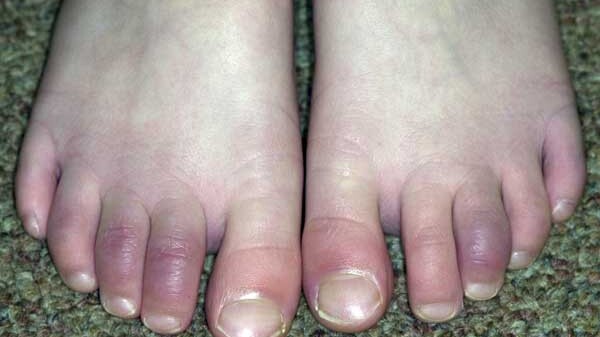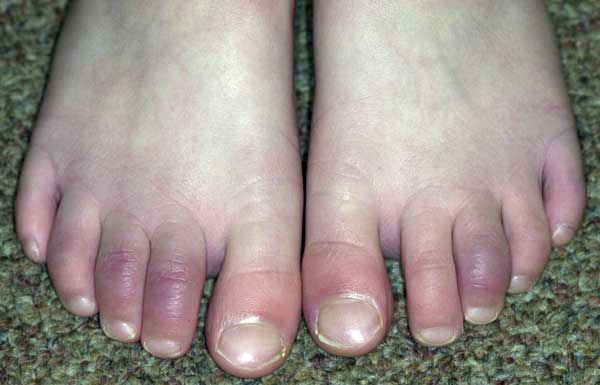
With our coldest start to Winter in over 70 years, I thought it was a timely reminder to discuss cold injuries to the feet. In recent winters I have seen a seen a proliferation of a condition called Erythema Pernio – common name, Chillblains. Even with our increase in activity this year with sports, social events etc resuming, our current cold snap and concerns about energy availability for home heating makes this topical once again.
So what are Chillblains? They are, quite simply, skin damage due to absent blood supply – either through repeated exposure to the cold, or due to the blood vessels acting abnormally and forgetting to open up again after cold exposure, if the change in temperature has been too abrupt. It usually occurs on the extremities – think toes – but can also occur on the nose, fingers and ears!

Once it has developed, the skin goes through several possible stages: itching and redness, burning, red, blue or purple patches, skin splitting and cracking, and in those with poor circulation, possible ulceration. Treatment includes nursing the injured skin back to health by keeping warm and dressing any sores with a simple dressing. Ointments can be used, best to ask your pharmacist what they recommend, and what they have in stock currently. It can take up to 3 weeks for Chillblains to heal, and they are often painful throughout the entire process. Not nice!
Let’s talk prevention. While there can be genetic and systemic reasons for Chillblains to occur, keeping warm is our main defence. Here are my top tips:
- Avoid barefoot at home during winter. Socks are an absolute minimum.
- Purchase good quality shoes or slippers for indoors. This is a whole topic on its own – if you are unsure, seek the counsel of a Podiatrist.
- Maintain a steady body and core temperature –
- Dress warm for the conditions. Use layers to trap heat.
- Avoid electric blankets – they heat the tissues too rapidly and can cause faulty messaging to the circulation. Using a wheat bag or similar at your torso is a better option.
- Avoid hot showers or baths when your body is cold, in particular your feet. Steady warming up is key.
- Keep active to optimise blood flow to all the peripheral parts of the body.
I hope my advice has reached you in time, it’s going to be a cold one this year!
As always, if you need further advice, feel free to reach out to the Podiatry team.
Hazel Rauch – Podiatrist SSPC Parkdale
You might like these other resources
Are Your Bones Strong Enough?
28 May 2024
BEWARE YOUR SCAN RESULTS!
23 February 2023
STAY OUT OF THE BASEMENT THIS SUMMER
23 December 2022
Staying Healthy – The Missing Pieces Of The Puzzle
17 November 2022
So I Don’t Need A Knee Reconstruction Anymore?
8 September 2022





